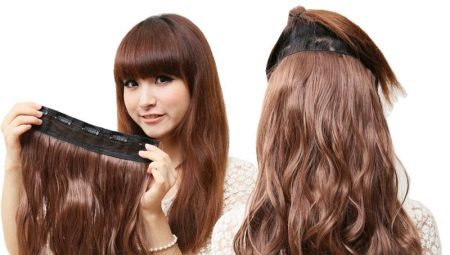Hair is the main component of the full image of a woman. Their condition affects visual perception.
For example, well-groomed and neat hair will always emphasize the beauty of a woman, regardless of whether she is made up or not. Sometimes when creating a daily or evening hairstyle and styling, you visually want to give curls more volume and density. In this case, false hair will always come to the rescue. What is it and how to fix it, we will consider in this article.

What it is?
False hair is a strand of natural or artificial hair that is attached to certain areas of the head. These strands are also called tresses or pads. There are many types of linings, which differ in the way of fastening, care and effect. You can find them in specialized stores that sell wigs or on the official websites of hair manufacturers.
It is very important for a woman that the linings look as beautiful and natural as possible, even if they are acidic in color and woven with braids.
The main goal is to look harmonious, well-groomed, and so that the tresses do not slip in the process of wearing.
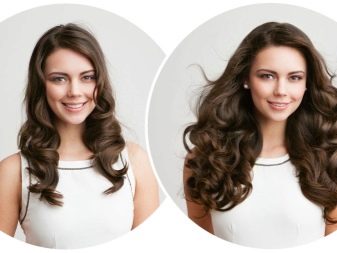
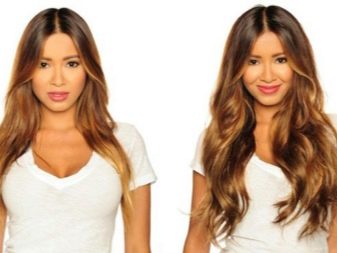
Advantages and disadvantages
The following positive qualities of the pads can be distinguished:
- give volume and length without hair extensions in capsules;
- easily and simply attached at home;
- minimize harm from socks;
- they can be removed at any time;
- can be painted (only natural);
- throughout the day they retain their shape, withstand the influence of external factors;
- can curl;
- no restorative procedures are required for your hair after removing the overheads.
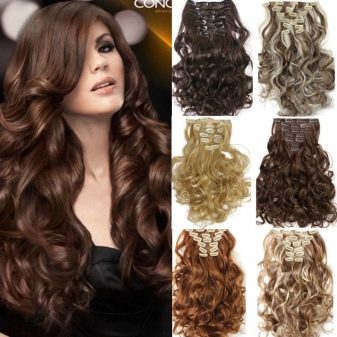
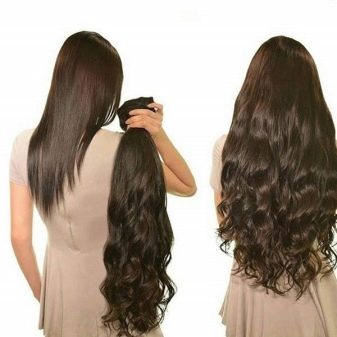
Of course, there are also disadvantages that you need to pay attention to when choosing:
- high price - the better the lining, the more expensive they will cost;
- curls dry for a long time after washing (about 9 hours);
- require sensitive care to maintain appearance;
- almost all types of linings need to be removed before bedtime to avoid damage;
- artificial strands are not stainable and do not tolerate curling and straightening at temperatures above 130 degrees;
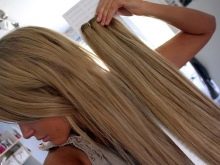
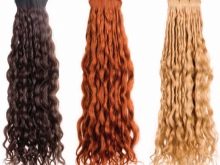
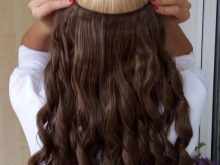
Kinds
The modern beauty industry offers many types of false hair in various forms of release: braids, volume buns, long and short. There are also a variety of shades (ranging from natural blond and black brunette, and ending with colored acid-yellow tresses), and this is not a complete list.
Consider the types of false hair by type of fastener.
Hairpin
These are strands of curls lined up in one ribbon, their beginning is fixed by hair clips in the form of small crabs. They are attached very simply. First, in turn, several parting is done on the head. It’s best to start from the bottom of the head, it’s easier to pin. The number of partings depends on the number of strands that will be attached. Then gently pin the pads at the hair roots with crabs.
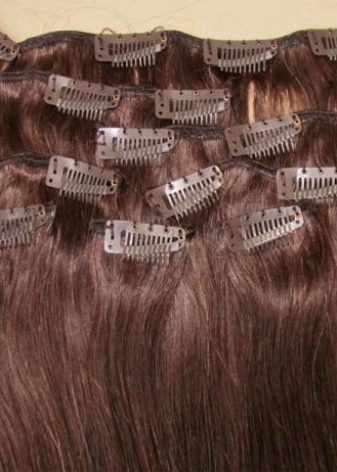
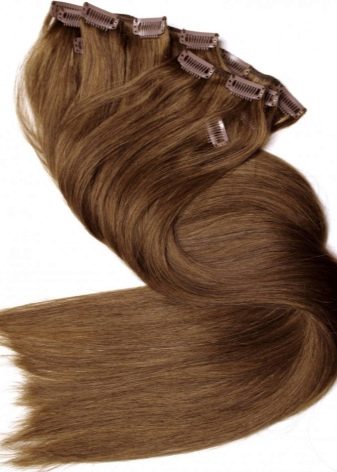
There is another, more reliable way of fixing: to attach a hairpin to the hair, passing hair through it, and at the same time pressing it to the head, then moving it in circular movements, and stabbing at the very roots. Thus, the hair will be fixed as much as possible.
You can not be afraid of the wind, rain, boldly shake your head - nothing will fly off.
The strands should not be too tight, but not too loose. It is very important not to feel discomfort, and if something went wrong, you can redo everything at any time without outside help.
Hairpins attached to the hair are usually small and durable, they are invisible and will not crumble when used. This is convenient because they can be used repeatedly. The strands of the greatest length are necessarily attached to the back of the head.
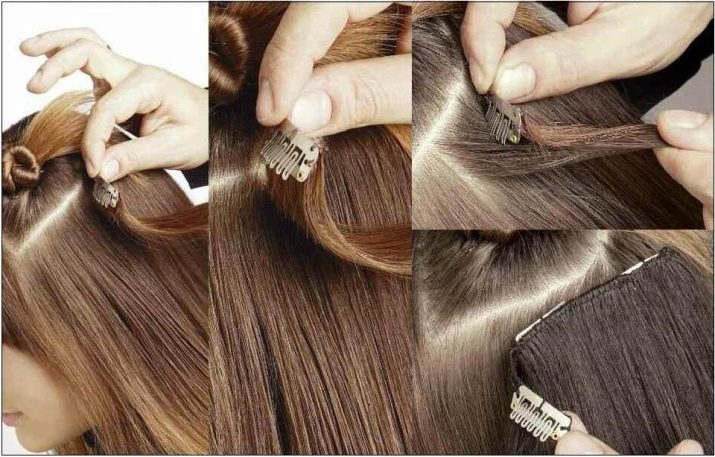
On an elastic band
Here, the hair strands are fixed with a wide elastic band, they are put on the top of the head and are complemented by a fishing line, which is regulated using fasteners. Attach very simply, without outside help. From above, they hide behind their hair, and they can also be twisted into a curling iron and straightened.
They are quite comfortable to wear, do not slip, so you don’t have to run to the mirror and correct.
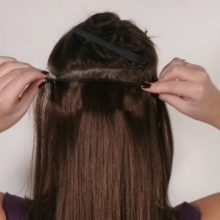
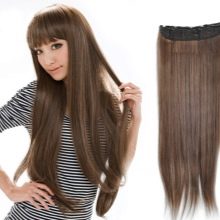
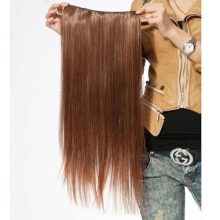
On sticky tape
This is the most “long-term” hair, and you will not need to worry for fasteners for 2-3 months. They are unpretentious in care, are not afraid of washing their hair, can withstand various influences (wind, heat, frost, moisture). They are short in width (about 40 mm), so it is very convenient to fix them on your own at home using sticky silicone tapes. They are glued at the base of the roots, so the hair looks natural.
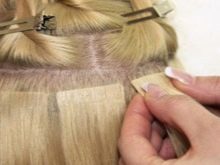
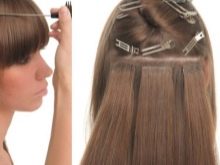
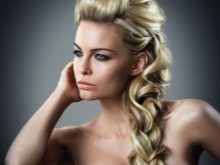
An essential factor in this acquisition is price. The high price is justified by the quality of hair, safety for native curls, hypoallergenicity and useful life. It is very important not to overdo the hair, because the roots at the base grow a few centimeters and the pads already look crooked and unnatural, they become noticeable.
It is worth mentioning that Only thermal hair is suitable for wrapping with a curling iron, so be sure to read the instructions on the packaging. Or you can find curly curls that do not require additional manipulations, except for careful combing.
In addition, overhead curls can be of very different lengths, starting with a square and ending with long strands up to 55 cm. It all depends on your preferences and purpose.
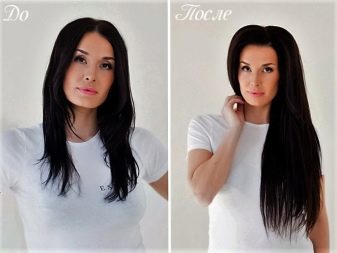
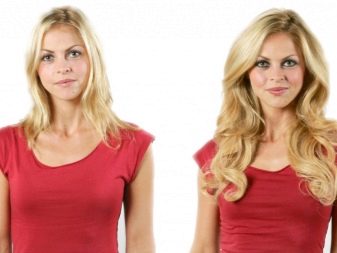
How to choose?
The choice of hair requires a careful approach, it is influenced by many factors: quality, price, color, type of fasteners, length, naturalness or artificiality.
If we talk about natural false hair on a hairpin, then they can be divided into 3 types: Slavic, European and Asian. Slavic hair is incredibly soft, thin, elastic, but it is also the most expensive in the price segment.
European strands are characterized by average density and thickness, they are cheaper than Slavic ones. Asian curls are the most dense, strong, thick, buying such hair will cost the least. It must be remembered that Asian curls are not suitable for Slavic girls, because their hair structure is different. Overhead curls of this format will stand out too much, differ from native ones, merge into one tone.
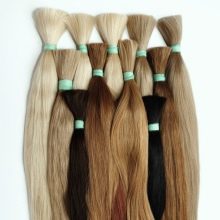
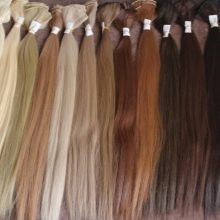
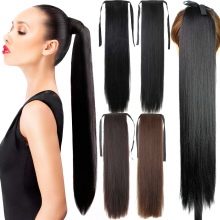
With color, everything is much more complicated, here you always need to choose the tone of your natural hair. This is best done in the store, while it is advisable to look at the strands in daylight - so you will not make mistakes.
The selection for highlighted curls is simple - locks of different colors fly apart and mix, so your hair will quickly gain a new look.
As for the price of overhead curls, it is worth noting that this pleasure is not cheap. However, if you plan to use the pads on an ongoing basis, you will need two sets so that hair care does not cause inconvenience. Some strands can be straight, others - wound. This is a good alternative not to spoil your hair again.
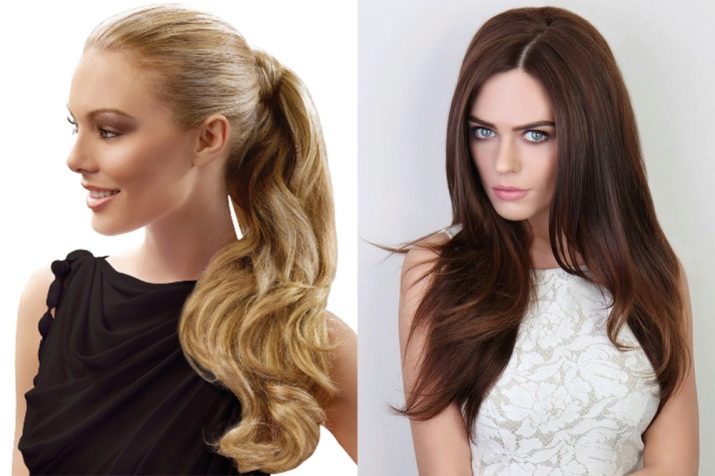
How to attach?
First of all, before you independently attach the false hair, you need to distribute the strands along the length. Estimate on an eye what lock you will put in the first place, and in what area of the head. It must be remembered that false curls are attached to clean and dried hair. It is advisable to make a small pile, however, this procedure is optional. In addition, you will need to divide the strands horizontally and secure with hairpins.
To the top of the head
This is one of those parts of the head where you want more volume and density. Shorter hair is attached to this area, for example, bangs, overlays or strands that will be closest to the face. Such overlays are perfect for owners of thinning hair with a short haircut. For the crown, there are special overlays on silicone tapes or clips in the form of a stack of curls. If these are strands, when fixed, they hide behind their natural hair on top.
Lining should not cause discomfort, after putting on, check the fasteners. To do this, bend a couple of times to the sides, shake your head slightly. If everything fits well and does not fall off, then you have correctly fixed the pads.
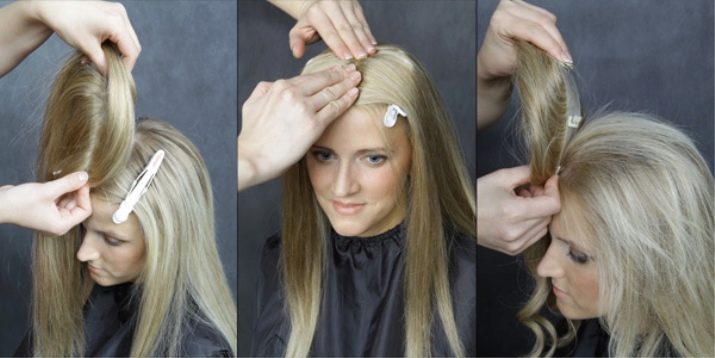
On the parietal part
Usually, in the parietal region, the strands are attached to the side, because if you attach them back, your native hair will be scattered on the sides while you are wearing them and the whole secret of a thick hairstyle will come to the surface. However, there is an exception, for example, when you collect hair in a ponytail. For Temiechka, longer strands are used, merging with relatives.
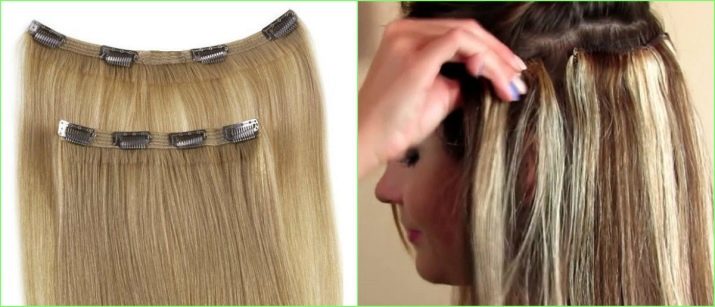
How to care?
Care for the linings is required, as it allows you to keep the shape and condition in the best possible way. Since the hair is constantly subjected to mechanical (combing, rubbing on clothes, skin) and thermal effects (wrap, straightening), you will have to take care of the curls regularly.
These procedures are not difficult. You need to comb your hair with a straight comb, starting from the tips and smoothly moving higher and higher along the curls. Press and stretch strongly should not be, if the hair is tangled, hold it a little higher than this place with your hand and try to unravel without the help of a comb.
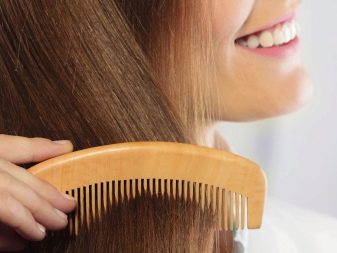

To wash natural linings, you must adhere to certain rules.
- Before the procedure, you need to comb the strands.
- Use shampoo for dry damaged hair.
- Do not rub hair during washing.
- Try to hold the locks along the entire surface so as not to overload them with the weight of water.
- After washing, pat your head with a towel.In no case do not wipe the curls.
- Natural linings are dried for 9 hours in a horizontal position, it is undesirable to use a hairdryer.
- To give the hair shine, elasticity and softness, use conditioners, spray for combing. It is not recommended to use oils.
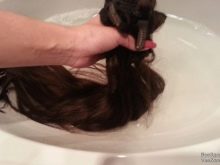

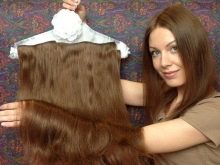
For artificial hair, the washing procedure is a little complicated, since they must be washed carefully in a container of hot water (previously brought to a boil).
- It is forbidden to use the same shampoo as for natural hair. Here you will need a tool for washing artificial hair, which can be bought in specialized stores. It is foamed in a small amount, then dipped in hair for 10 minutes.
- After that, they are washed with cool water 2-3 times, and it is important to make sure that the shampoo is completely washed off.
- Then the curls are dried with a towel or hung on a rope. The hairdryer is used only in extreme cases, and only with the supply of cold air.
In general, overhead strands are washed no more than once every 2 weeks with everyday wear. The tap water is too hard, so in order to maintain the integrity of the curls it is worth washing them with baking soda. Be sure to pamper the false hair with masks and various care products - this affects their softness, elasticity and shine.
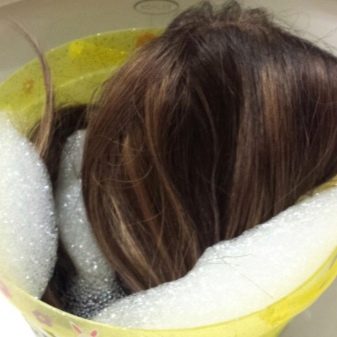
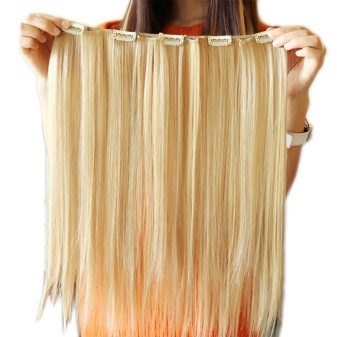
Paint
There are times when the hair color is not exactly like your shade, and this can only be fixed by dyeing. It should be noted that only natural strands lend themselves to this procedure. It is best to entrust this to a professional in the salon, however, you can do it at home. The hair should be clean and dry. Consider the step-by-step staining process in more detail.
- Prepare the paint.
- First test on one of the strands to see the reaction to the mixture.
- Apply paint from the tips, and try to evenly distribute along the entire length.
- Dyeing time is 2 times less than for native hair. If the bundle says 20 minutes, do not hold the dye for more than 10. This is because artificial hair is more vulnerable to chemical reactions.
- Rinse the curls under running water until the paint is completely removed, be sure to apply the balm, which is stored in the package with the paint.
- Dry your hair for 9 hours by hanging it on fasteners and do not expose it to a hair dryer.
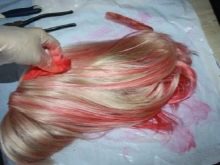
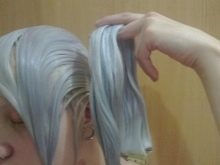
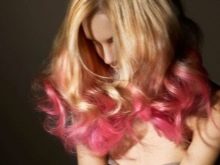
Wind up
Most often, false hair is used to create hairstyles or hairstyles, so that the overall look looks luxurious. Therefore, most likely, they will be wound or straightened for further manipulations.
As mentioned earlier, the package must be marked that they can be exposed to temperature. The temperature of heating the curling iron should not exceed 170 degrees.
Wrapping occurs in the same way as on your hair. The strand is fixed and wound with a curling iron, aged for about a minute. After this, the main stage follows: remove the curling iron from the lock, holding the curled curl, pin it with a hairpin or invisibility, and wait until it cools completely. Thus, the shape is preserved, the curl does not break up.
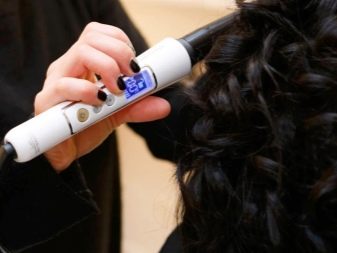
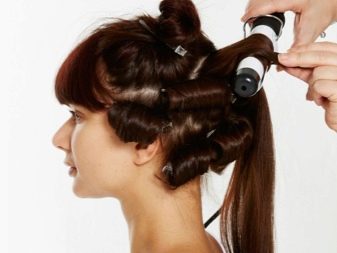
Hairstyles Options
The easiest, everyday option to wear pads - straight loose hair. The second common option is curls wound on a conical curling iron.
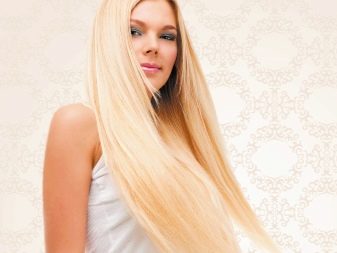

French braids are another reason why you should attach extra strands. Due to its density, a beautiful magnificent braid makes the image more interesting and universal, it is relevant in the morning and evening.
Recently, it has been fashionable to use colored Kanekalon, braiding boxing braids. In addition, pigtails on top can be decorated with flowers made of foamiran or stones - this will look natural and unusual.
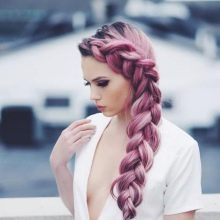
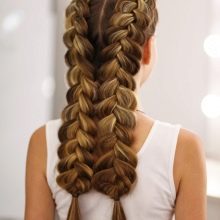
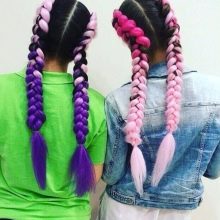
Shells or bunches are a great idea on how to use overhead locks. One has only to acquire invisibles, hairpins, hairspray and patience, as the original bundle in your design is ready.
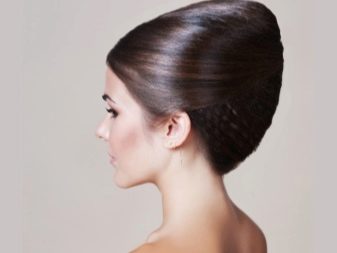
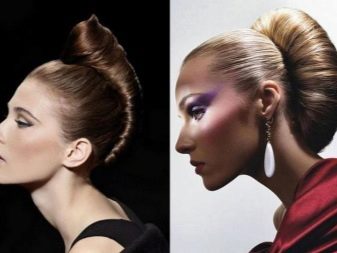
You can learn about how to wear natural hair on hairpins from the video below.
